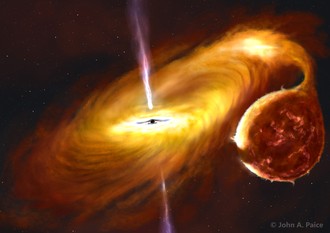
An international team of astrophysicists from the South African Astronomical Observatory (SAAO), the University of Southampton, Institut d’Astrophysique de Paris, the Nicolaus Copernicus Astronomical Center in Warsaw (Jean-Pierre Lasota) and the Harvard-Smithsonian Center for Astrophysics, have found large variations in the brightness of light seen from around one of the closest black holes in our Galaxy, 9,600 light-years from Earth, which they conclude is caused by a huge warp in its accretion disc.
This object, MAXI J1820+070, erupted as an X-ray transient in March 2018 and was discovered by a Japanese X-ray telescope onboard the International Space Station. X-ray transients are binary systems that exhibit violent outbursts occurring in an accretion disc surrounding a compact object. In this case, MAXI J1820+070 contains an 8.5 sollar masses black hole accreting matter lost by a low–mass stellar companion.
The discovery presented in the paper published in the Monthly Notices of the Royal Astronomical Society was made from an extensive and detailed light-curve obtained over almost a year by dedicated amateurs around the globe who are part of the AAVSO (American Association of Variable Star Observers). MAXI J1820+070 is one of the three brightest X-ray transients ever observed, a consequence of both its proximity to Earth and being outside of the obscuring plane of our Milky Way Galaxy. Remaining bright for many months made it possible to be followed by so many amateurs.
Massive X-ray outbursts in binaries occur when the material accumulating in the disc during quiescence (in which the system spends most of the time) becomes unstable. This brings the whole disc to a hot state which tremendously increases accretion onto the black hole and releases copious amounts of energy before matter traverses the event horizon.
The research team have produced a visualization of the system, showing how a huge X-ray output emanates from very close to the black hole, and then irradiates the surrounding matter, especially the outer disc, heating it up to a temperature of around 10,000K, which is seen as the visual light emitted. That is why the optical light follows the decline of X-rays.
Almost 3 months after the outburst began, the optical light curve started a huge modulation — on a period close to the orbital one, of about 17 hours. Yet there was no such change seen in the X-ray output. While small, quasi-periodic visible modulations had been seen in the past during other X-ray transient outbursts, nothing on this scale had ever been seen before.
With the angle of view of the system as shown in the pictorial, the usual explanation that the X-rays were illuminating the inner face of the donor star could be ruled out because the brightening was occurring at the wrong phase. Nor could it be due to varying light from where the mass transfer stream hits the disc as the modulation gradually moved relative to the orbit.
This left only one possible explanation, the huge X-ray flux was irradiating the disc and causing it to warp. The warp provides a huge increase in the area of the disc that could be illuminated, thereby making the visual light output increase dramatically when viewed at the right time. Such behavior had been seen in X-ray binaries with more massive donors, but never in a black-hole transient with a low mass donor like this. The radiative disc warping has been theoretically discovered by James Pringle in 1996, studied in the case of binaries by Gordon Ogilvie and Guillaume Dubus in 2001 and predicted to occur in Low Mass X-ray Binaries by Carol Haswell and collaborators, also in 2001.
Starting some 5 years ago, a major science program on the Southern African Large Telescope (SALT) to study transient objects has made a number of important observations of compact binaries, including black hole systems like MAXI J1820+070. As the Principal Investigator for this program, Prof. Buckley, states “SALT is a perfect tool to study the changing behavior of these X-ray binaries during their outbursts, which it can monitor regularly over periods of weeks to months and can be coordinated with observations from other telescopes, including space-based ones.”
DOI: 10.1093/mnras/stab3033
Bibliography
Pringle J. E., 1996, MNRAS, 281, 357
Ogilvie G. I., Dubus G., 2001, MNRAS, 320, 485
Haswell C. A., King A. R., Murray J. R., Charles P. A., 2001, MNRAS, 321,475
SALT is currently funded by a consortium of international partners from South Africa, the United States, Poland, India and the United Kingdom. NCAC coordinates the Polish participation in the consortium.
Text: Jean-Pierre Lasota
Picture: Black hole with warped disc in a binary system (artist's version).
Picture credit: John A. Paice






